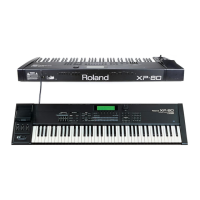52
If you want to use a fixed tempo in Performance mode
(Perform Tempo parameter setting), set the Clock Source
parameter (PERFORM/Common/Common) to PERFORM
and set the desired tempo.
If you want to use the sequencer’s tempo clock in
Performance mode, set the Clock Source parameter (PER-
FORM/Common/Common) to SEQUENCER.
KEY-OFF-N: The Tone will not sound while the key is being
pressed, but will sound after the Time parameter setting, if
the key is released.
KEY-OFF-D: The Tone will not sound while the key is being
pressed, but will sound after the Time parameter setting, if
the key is released. Please remember that this setting allows
the TVA envelope of the Tone to begin changing, so in most
cases only the decay portion of the sound will be heard.
✳ If you have selected a decay type sound wave (i.e., a
sound that fades naturally even if the key is not
released), selecting KEY-OFF-N or KEY-OFF-D may
result in no sound being produced.
TEMPO-SYNC: If you select a Wave with tempo (BPM)
being displayed when an optional Wave Expansion Board
such as the “SR-JV80-10: BASS & DRUMS” is installed, the
Tone will synchronize to the tempo clock of the sequencer
regardless of which key is pressed. This is most effective
when playing phrase loops in sync with the tempo of a song
(p.179).
If you want to sync to the tempo of a song in Patch mode, set
the Clock Source parameter (PATCH/Common/Common
General) to SEQUENCER.
If you want to sync to the tempo of a song in Performance
mode, set the Clock Source parameter (PERFORM/
Common/Common) to SEQUENCER.
✳ When TEMPO-SYNC is selected, pitch and FXM set-
tings will be ignored.
✳ When selecting TEMPO-SYNC, also set the Time para-
meter to 0. If other values are set, Tone Delay will be
activated.
Time (Tone delay time)
Specifies the time that elapses from when the key is pressed
(or from key release if KEY-OFF-N or KEY-OFF-D has been
selected for the Mode parameter) to when the Tone will
sound (using Tone Delay).
If PLAYMATE has been selected for the Mode parameter, a
setting of 64 will set delay time to the interval between the
previous Note On and the current Note On. To extend time
about twice as long as a 64 setting, try 127. To cut the time
by half, try setting it to 32. At a 0 setting, the Tone will not
sound. For example, to make two notes sound (one note fol-
lowed by the other) with one key, use two Tones and set one
Tone’s Time parameter to 0 and the other Tone’s Time para-
meter to 32 or whatever delay you prefer.
If the Mode parameter is set to CLOCK-SYNC, the setting
will be in quarter-note steps, and the corresponding note
value symbol will also be displayed. This lets you specify the
delay time in note length relative to synch tempo. For
instance, if the tempo is 120 with resolution set to 96= ,
delay time will be 0.5 second. In other words, a tempo of 120
produces 120 quarter-notes per minute (60 seconds), so 60
divided by 120 equals 0.5 second.
✳ If Structure Type 1&2 (or 3&4) parameter (PATCH/
Common/Structure) is set to Type2–10, the outputs of
Tone 1 (or 3) and 2 (or 4) will be combined into Tone 2
(or 4). The settings of Tone 1 (or 3) will be ignored.
Pitch display
You can set the WG pitch of each Tone.
Coarse Tune
Adjusts pitch in semitone steps (-4– +4 octaves).
Fine Tune
Adjusts pitch in 1-cent (1/100th of a semitone) steps (-50–
+50 cents).
Random Pitch Depth
For random pitch changes with every key press, use this
parameter to set the desired amount (in cents) of pitch
change. If you don’t want random pitch changes set it to O.
Pitch Keyfollow
Sets the amount of pitch change as you move 1 octave on the
keyboard. The pitch change is displayed graphically.
For a conventional keyboard pitch change of 1 octave when
keyboard position goes up 1 octave, set this parameter to
+100. For a 2 octave pitch changes when keyboard position
goes up 1 octave, set this parameter to +200. Negative (-) val-
ues will lower pitch even as you go up the keyboard. A set-
ting of 0 makes all keys have the same pitch.

